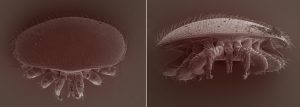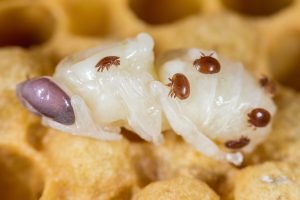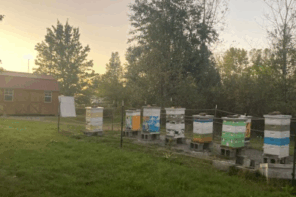 Jeff Kennedy
Jeff Kennedy
Pollinating insects are critical to sustainable crop yields and their quality. As our ever-growing population becomes more dependent on efficient food production, maintaining healthy pollinator populations has become increasingly more important. Our beloved honey bees are the chief pollinator of crops here in the United States, but over the past several decades, colony numbers have steadily declined due to a myriad of reasons. One of these reasons is parasitism by Varroa destructor (Varroa) which is typically the culprit for the failures experienced by hobbyist, sideliners and commercial beekeepers alike.
For the novices out there, Varroa is a parasitic bee mite that has wreaked havoc on beekeepers throughout the world and has forever changed the industry. Varroa was first reported in honey bee colonies from Hong Kong in 1962, and then popped up again in 1963, this time in the Philippines. With reports of it making its way to the Port of Newcastle in Australia last year, it is looking as if Varroa will now become established on every continent due to the commercial transport of bees and queens, migratory beekeeping practices, natural swarming and drift or carried by ships and aircraft.
Varroa Physiology
The adult, female Varroa is oval and flat, measures about 1.1 mm long and 1.5 mm wide, is pale to reddish-brown in color, and can be seen easily with the unaided eye. Males are considerably smaller and are pale to lightly tan in color. Adult bees serve as intermediate hosts when little or no brood is available and as a mechanism of transport. Females will attach to an adult bee between their abdominal segments or between regions of their body (head/thorax/abdomen), making them difficult to detect. It was originally thought that the mites fed exclusively on the bees’ hemolymph (invertebrate equivalent of blood); however, recent studies conducted by Dr. Samuel Ramsey, affirmed that the mites damage the host bees by consuming their fat body, a tissue roughly analogous to the mammalian liver. The fat body is integral to proper immune function, pesticide detoxification, overwinter survival and several other essential processes in healthy bees.
The most severe parasitism occurs on the older larvae and pupae, with drone brood being preferred to worker brood. The degree of damage depends on the number of mites parasitizing each bee larva. One or two mites will cause a decrease in vitality of the emerging bee. Higher numbers of Varroa per cell result in malformations like shortened abdomens, misshapen wings, deformed legs or even the death of the pupa. In addition, their feeding on immature/developing bees is a confirmed vector of five debilitating viruses and potentially 13 others.
The adult, female Varroa will enter brood cells shortly before they are capped and must feed on the larvae before they can lay eggs. Each mite will lay two to six eggs every 30 hours. The first egg usually emerges as a male and the later ones as females. The development from egg to sexually mature adults occur from six to 10 days. The mites will then mate inside the capped cells, with the males dying afterwards. All immature mites will die after the emerging bee opens the cell, while the young, adult female mites and mature (gravid) females move on, attaching to bees passing by. The mite then enters another brood cell to repeat this process.
Varroa Sensitive Hygiene (VSH) & Selective Breeding
The USDA-ARS Honey Bee Breeding Lab in Baton Rouge has bred bees that hygienically remove mite-infested pupae from capped worker brood. This ability is called Varroa Sensitive Hygiene (VSH), and is an important mechanism of resistance to Varroa. The bees that express high levels of this behavior are referred to as VSH bees. The best resistance is found in pure VSH bees; however, hybrid VSH bees (e.g., VSH queens open mated to non-resistant drones) are reported to have significant resistance to Varroa.
VSH is similar or the same as hygienic behavior that honey bees use to combat other diseases such as American foulbrood, chalkbrood, and towards the eggs and larvae of wax moths and small hive beetles. All colonies likely have individuals that exhibit VSH traits, and it is not yet fully understood how selective breeding has resulted in colonies with greatly improved performance. Hygiene is performed by nest cleaning bees aged 15-18 days old. Removal of a mite-infested pupae begins when a nest cleaner smells the infested brood and chews a pinhole through the cell cap. Subsequently, additional nest cleaners assist in enlarging the hole and removing the diseased pupae from the brood cell.
Removal of mite-infested brood is probably triggered by unusual odors that penetrate the cell cap to the outside where hygienic bees patrol the comb surface. VSH bees have been observed responding vigorously to highly infested brood (e.g., 15–25 mites per 100 capped cells) that is transferred into the colony. They uncap and remove many mite-infested pupae quickly. They respond with much less intensity to brood with low infestation rates (one to five mites per 100 capped cells), probably because the chemical signals that trigger removal are less concentrated and harder to detect.
Another characteristic of VSH bees is reduced fertility in the mites, when compared to non-VSH bees. In a colony, mite fertility is reduced several weeks after introduction of VSH queens into non-selected colonies. This led to the original name of the trait, Suppressed Mite Reproduction (SMR). This name describes the trait (or traits) selected in the experimental population of bees. The name of the trait was later replaced by Varroa Sensitive Hygiene. This is due to the finding that the primary mechanism of the trait is the removal of infested pupae from capped brood cells.
Is the Proof in the Puddin’?
Currently, there are just a handful of queen producers that are using instrumental insemination to control and isolate pure VSH genetics within their apiaries. So far, it is looking very promising even for the openly mated, hybrid queens that derive from VSH stock. As I alluded to earlier, if we can agree that most colonies exhibit some degree of hygienic behavior, then the addition of a hybrid, VSH queen should enhance the colony’s hygienic behavior that much more, right? We began incorporating VSH genetics into our stock years ago and have consistently seen a decrease in infestation rates during peak season, mite washes. However, I am not naïve enough to put all of my faith into or to hope for a silver bullet. I believe that the success(es) we experience within our operations are the result of taking a multi-pronged approach to husbandry. But let’s see some data.
A 2011 study conducted by Robert Danka, Jeffrey Harris and José Villa, of the USDA-ARS Honey Bee Breeding Lab, offers more insight.
The lab tested six commercial sources of honey bees, whose breeding practices incorporated the VSH trait. VSH production queens (i.e., queens commercially available to beekeepers) from the six sources were established in colonies and monitored for VSH. The data was compared with data from three other types of queens: 1) VSH queens from the selected, closed population maintained by USDA-ARS for research and breeding/germplasm, 2) queens from the cooperating, commercial distributor of this germplasm (Glenn Apiaries) and 3) queens of a commercial, mite susceptible source.
Glenn Apiaries of Fallbrook, CA maintained a breeding population of VSH colonies through instrumental insemination, adding new genetic material annually from further selections provided by the USDA-ARS Lab. Their operation also combined the VSH trait into multiple stocks that were desired by beekeepers. Glenn’s instrumentally inseminated breeder queens were sold to queen producers to incorporate into their own breeding program or to use as mothers of production queens for beekeepers. How much these intermediate breeding efforts affect the expression of VSH in production queens is unclear. This is due largely in part to the difficulty of measuring the trait which prevents breeders, queen producers and beekeepers alike from assessing it in their own bees.
Harris and John Harbo (also of the USDA-ARS Lab) had previously reported in 2001 that although pure VSH queens yield colonies with the greatest resistance to Varroa, daughters of VSH queens that outcross by mating with non-VSH (and presumably mite-susceptible) drones retained a significant level of mite-resistance. Their collective data showed that mite populations in these hybrid colonies remained low during tests lasting a few months in duration. Their study suggested that beekeepers could derive immediate benefits from mite-resistant queens that have free-mated to unselected drones. They offered that the production and distribution of these free-mated queens from many commercial sources may be an effective way to insert beneficial genes into our commercial populations of honey bees without losing the genetic diversity and the useful beekeeping characteristics of this population.
The data collected in the 2011 study showed that the reduction in mite infestation of brood combs differed significantly between the groups. On average, colonies with VSH production queens reduced infestation by 44%. Not surprisingly, the optimum results, or those with the greatest mite removal, were the pure USDA-ARS VSH queens (76%) and the Glenn Apiaries VSH queens (64%). The colonies with the least removal were the commercial, mite susceptible queens (7%).
Colony-to-colony variation tended to be greater within the VSH production and commercial, mite susceptible colonies than the USDA-ARS and Glenn Apiaries VSH colonies. The VSH production queens had variable expression of hygiene against mites, with average reduced infestations ranging from 22 to 74%. In addition, infertility was high among mites that remained in infested cells within the USDA-ARS and Glenn Apiaries VSH colonies, but was lower and more variable in VSH production and the commercial, mite susceptible colonies. Commercial VSH production colonies supply mite resistance that generally seems to be useful for beekeeping, and the resistance likely could be improved upon if more VSH drone sources were available when VSH production queens are openly mated. Dare I suggest that a viable, business endeavor for an ethically sound, entrepreneurial beekeeper with the ability to run a closed breeding population would be to produce excess VSH drones that could be marketed as three pound drone packages? This would assist beekeepers who are interested in building upon the VSH trait to flood their DCA’s with VSH drones to help increase the percentage of the VSH trait within their openly mated, hybrid queens.
The Silver Bullet Lacks Gun Powder
I have a source close to me that was the head apiarist for Florida state during the early 2000’s when the VSH trait was being developed. He informed me that he was present when Harbo and Dr. H. Glenn Hall, Professor of Entomology for Florida University developed a mite resistant line of Apis mellifera.
Harbo was working on his VSH stock and Hall was paralleling him to validate the data. Hall succeeded at breeding honey bees that were resistant to Varroa, and found that like Varroa’s original host Apis cerana, resulted in smaller colonies about the size of a soccer ball. The conclusion being that if you bred mellifera so that it was not large enough to have a massive amount of brood present during the majority of the year, you could have honey bees that were resistant to Varroa. The trade-off is that a colony such as this is of no value for honey production or crop pollination due to its low population.
So, the verdict is still out, so to speak. Over two decades worth of persistent study by universities, agricultural extensions, and beekeepers have all yielded roughly the same results when it comes to VSH. The closer that you stay to a controlled or “pure” line will produce the highest rate of hygienic behavior. As you start to branch away from pure lines (i.e., hybrid, VSH queens) and they begin to openly mate with local, mite-susceptible drones, the traits are less influenced.
When it comes to combating Varroa, I am receptive to any possible solution that will tip the scale in our favor. I am appreciative of the extensive amount of work that has and continues to go into developing this trait further. I see potential down the road for incorporating this trait within your apiary; however, I will remain vigilant in my management practices and continue to be a proactive, not a reactive beekeeper. There is no silver bullet. At least not yet.










